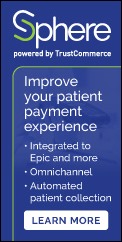News 1/13/21
Top News
ONC releases United States Core Data for Interoperability Draft Version 2 for public comment.
Reader Comments
From What the HIMSS?”: “Re: HIMSS21. Any idea of how it will look? I hear a hybrid in-person and virtual approach. I’m not sure what that would even look like or if it would be worth my time to attend.” I haven’t heard anything, but I am interested in what readers have heard, especially exhibitors who are usually the first to know. Big conferences seem iffy to me for 2021 given that:
- Our country’s vaccine rollout in a raging pandemic is plodding along, pushing herd immunity far down the road, and that’s assuming that new virus variants don’t make the situation worse.
- Attendance, presentation, and exhibitor decisions will need to be made fairly soon even as attention and stretched cash are being directed elsewhere because of the pandemic.
- An unknown number of folks won’t be comfortable herding into crammed spaces of unknown ventilation any time soon, regardless of mitigation measures.
- Hospital employees are busy dealing with COVID demands that may or may not end by August.
- It will have been 18 months since HIMSS19 when HIMSS21 rolls around, so the bandwagon effect that has always guaranteed big registration numbers will be diminished.

From Listicle: “Re: Becker’s. Found this on Twitter.” The various Becker’s publications are mostly written by recent college grads (this one from the class of 2020) whose entire job is looking up stuff someone else posted online and paraphrasing it while applying no expertise beyond wordsmithing. Most “news” sites think their readers are too unmotivated to read a story that doesn’t have pictures, so they resort to using irrelevant stock art and photos when everything else is copyrighted by the original source. Adding insult to injury in this case is that the Tweeter declared the swap of the photo of a black doctor with a white one to be racist, failing to notice that the original one isn’t Adekunle Odunsi, MD, PhD either (Google would have saved her some embarrassment). Not to mention that it’s pretty obvious that these are stock photos. Anyway, that’s just how these sites work since news has turned into a zip-bang-pow comic book for people who can’t read more than three consecutive sentences without breaking for a fun video.
HIStalk Announcements and Requests

I might be the only person who didn’t know that several companies sell USB 3.0 flash drives that are equipped with a Lightning plug that lets you move photos off your IPhone, perform automatic backups, stream video, and exchange files with other devices. It’s probably worth a shot at around $40 for 128 GB, even with some user reports of buggy required software, but still frustrating that you just plug MicroSD cards into Android phones while Apple’s lack support for external memory requires after-market gadgets, cords, and adapters.
Listening: The Fly-Bi-Nites, a long-defunct psychedelic band from Atlanta that made the “Found Love” 45 single in 1967, sold 300 copies, then disbanded when its members went to college. Singer and co-writer Greg Presmanes still records occasionally (country music, though, in an interesting pivot) and is a 72-year-old partner in an Atlanta law firm who must have some great stories to tell his grandkids. I Shazam’ed the song while watching Season 1 of the pretty good “Hap and Leonard” series on Netflix and appreciating its bizarre soundtrack that ranges from the aforementioned psychedelia to hippie-hating, throaty country warblers that were all the rage in the Vietnam-divided 1960s.
Webinars
January 13 (Wednesday) 2 ET. “The One Communication Strategy Clinicians Need Now.” Sponsor: PerfectServe. Presenters: Clay Callison, MD, CMIO, University of Tennessee Medical Center; Nicholas E. Perkins, DO, MS, hospitalist and physician informaticist, Prisma Health. Healthcare organizations are leveraging their current investments and reducing their vendor footprint, so there’s no room for clutter in healthcare communication. The presenters will describe the one communication strategy that clinicians and organizations need today, how to improve patient experience and protect revenue, and how to drive the communication efficiency of clinical teams.
Previous webinars are on our YouTube channel. Contact Lorre to present your own.
Acquisitions, Funding, Business, and Stock

Home care coordination software vendor Dina raises $7 million in a Series A funding round. The Chicago-based company has also developed an AI-powered virtual assistant for patients and software to help employers with staff availability tracking and automated COVID-19 screening.

Health data and analytics company Komodo Health secures $44 million in Series D funding and acquires Mavens, a cloud-based technology company that is focused on biotech, rare disease, and specialty pharma markets.
![]()
Central Logic acquires Acuity Link, a developer of communications and logistics management software for healthcare transportation.
Sales
- Community Health Network (IN) selects automated appointment scheduling and chatbot software from Loyal.
- Scripps Mercy Partners (CA) will implement Doctible’s patient relationship management technology across its practice network.
- La Rabida Children’s Hospital selects Emerge for clinical data access.
People

Jim Corrigan (ERT) joins ConnectiveRx as president.

SOC Telemed names Ron Egan (GE Healthcare) chief customer officer.

Heidi Kemp, MEd (The SSI Group) joins Medstreaming as VP of marketing and channel partners.
Announcements and Implementations
Dominion Radiology Associates (VA) implements Spok Go care team messaging software.
Nuance announces GA of its Patient Engagement Virtual Assistant Platform.
Prescription patient engagement service vendors Pleio and Medisafe launch GoodStart, in which patients who are starting new prescriptions are supported with live calls and digital nudges from Pleio’s concierge program, then transition to Medisafe’s medication management services.
Athenahealth will include health plan data in its display of patient medical records in a collaboration with insurer Humana.
Healthcare Growth Partners publishes its twice-yearly market review, which is so brilliantly written and admirably concise that any attempt I would make to summarize it would do more harm than good. It’s not a dispassionately nerdy investor view of obscure data points, but rather a big-picture view of our entire industry. I don’t strew editorial superlatives indiscriminately, but I can’t help but fawn over an investor-focused report that grabs me with this brilliant opening paragraph that is as close to poetry as you’ll get in a financially focused report:
The paradox of a raging bull market amidst a raging pandemic is a reality nearly impossible to reconcile. While health IT fundamentals are as strong as ever, it feels cavalier to begin our market discussion without recognizing the toll of this pandemic. After all, we at HGP and readers of our research choose to be in healthcare because we collectively believe in the industry’s responsibility to serve the greater good. We know our industry is fraught with moral hazard, and while a few seek to exploit, most aim to solve. Fueled by low interest rates and stimulus, the pandemic has bolstered the investment thesis in health informatics, yet we know the gains will never atone for the losses.
Government and Politics
HHS allocates $8 million to the three-year Telehealth Broadband Pilot program, which helps rural providers assess broadband capacity and implement virtual care.
Banner Health pays $200,000 to settle HIPAA Right of Access violations involving five-month delays in giving two patients access to their records.
The owner of an Orlando telemarketing center is convicted of federal charges of healthcare fraud for cold-calling Medicare beneficiaries to offer them “free” cancer genetic tests, bribing telemedicine doctors to order the $6,000 tests without ever talking to the patient, and then selling the resulting orders to laboratories in return for kickbacks. Labs submitted $2.8 million of the claims, Medicare paid $880,000, and the call center owner made $180,000.
COVID-19
The latest COVID-19 statistics for the US as of Monday:
- 129,748 people are hospital inpatients.
- 1,739 people died.
- Deaths are at 376,000.
- States with the highest number of deaths per 100K population in the past week are Arizona, Pennsylvania, Tennessee, and West Virginia.
- 9 million vaccine first doses have been administered of the 25.5 million doses distributed, leaving two-thirds of available doses sitting in freezers.
US Representatives Bonnie Coleman (D-NJ), Pramila Jayapal (D-WA), and Brad Schneider (D-IL) test positive for COVID-19 after sheltering in place in the Capitol last week along with several Republican colleagues who refused to wear the masks that they were offered. Congresswoman Coleman is a 75-year-old cancer survivor.
New York City’s comptroller says that online COVID-19 vaccine signup is so complicated that appointment slots aren’t being filled. He says that setting up an account involves a multi-step verification process, six more steps are needed to set up an appointment, and the user is required to complete up to 51 data fields and upload an image of their insurance card. A college professor says it took her 4.5 hours to find a location and make an appointment. The city has three sign-up websites, seven community clinics each have their own, four require calling them on the phone, and one involves email.
HHS will ask hospitals to submit weekly numbers on how many of their employees and patients have been vaccinated.
The family of a healthy, 50-year-old Beverly Hills plastic surgeon who died of COVID-19 says he was infected when a patient on whom he was performing a lip injection coughed on him, then called the office days later to let them know she had since tested positive for COVID-19.
Former White House coronavirus adviser Scott Atlas, MD deletes his Twitter after complaining that he lost 12,000 followers in a purge of accounts that were spreading misinformation.
A London-based mathematician-epidemiologist and public health professor illustrates the potential number of deaths from a more transmissible strain such as the B117 variant (yellow line) versus a strain that is 50% more lethal (red) or the original virus strain (gray). Ireland’s case count has jumped six-fold in just a couple of weeks as B117 became the dominant strain (9% of cases on December 27 versus 46% on January 10).
Beaumont Health (MI) CIO Hans Keil says the system tripled its server capacity over the weekend to better handle patient requests for COVID-19 vaccine appointments through its Epic MyChart patient portal. The system crashed Friday morning after nearly 9,000 patients — 10 times the usual number — attempted to access it at the same time.
WHO says that global COVID-19 herd immunity is not likely to be reached this year, making it critical that countries maintain mitigation measures, especially as poorer countries struggle to obtain vaccine whose supply is being bought up by wealthier ones.
Well Health develops a COVID-19 vaccine rapid deployment and implementation program that includes pre-appointment resources.
Other

An analysis in JAMA of medical fundraisers conducted on GoFundMe shows that users sought more than $10 billion and raised $3 billion in charitable contributions over an eight-year period. Treatment for cancer and trauma/injury were the top fundraising categories.
Sponsor Updates

- Santa Rosa Consulting staff donate toys and books to Toys for Tots.
- A local news podcast features Arcadia Chief Medical Officer Rich Parker, MD discussing Community Health Plan of Washington’s rollout of the company’s COVID-19 vaccination education and engagement platform.
- Artifact Health publishes a new case study, “OU Health standardizes physician query workflow and achieves positive results.”
- Vaco and Pivot Point Consulting launch a LinkedIn Live series that showcases female leaders across all industries.
- The Chartis Group unveils Next Intelligence branding.
- Ellkay features Meditech EVP Helen Waters in the latest installment of its Women in Health IT series.
- The National Quality Forum re-appoints Health Catalyst SVP of Professional Services Stephen Grossbart to its Primary Care and Chronic Illness Standing Committee.
- Change Healthcare helps providers comply with the CMS Price Transparency Rule with its Shop Book and Pay and Clearance Estimator Patient Direct solutions.
- Saykara wins a 2021 BIG Innovation Award for its AI-powered voice assistant that automates clinical charting, and the 2021 Sharp Index Award for “Best Health Tech Company to Reduce Burnout.”
- Central Logic adds Intelligent Transport and Bed Visibility capabilities to its healthcare access and orchestration technology.
Blog Posts
- Why It’s So Important to Perform Clinical Validation During EHR Data Conversion (314e)
- Top 10 Tips to Start Your Healthcare ESignature Project Now (Access)
- Prestera Health exposes 3,700+ patients’ info in email breach (AdvancedMD)
- Agfa HealthCare supports leading hospitals in Latin America (Agfa HealthCare)
- Differentiate Yourself: Upgrade Your Virtual Care Platform Strategy (Bluetree)
- The Hidden Benefits of a Legacy Data Management Strategy (CereCore)
- The Compelling Case for ‘Healthcare Access and Orchestration’ and Why It Matters (Central Logic)
- The 4 cybersecurity resolutions every care provider should make in 2021 (Cerner)
- Combating Ransomware: Preparation and Teamwork (Dimensional Insight)
- How HEDIS Analytics is Helping Healthcare Practices (EClinicalWorks)
Contacts
Mr. H, Lorre, Jenn, Dr. Jayne.
Get HIStalk updates.
Send news or rumors.
Contact us.

























































That, or we see if Judy will announce Epic's new Aviation module (probably called Kitty Hawk) that has integrated Cruise…